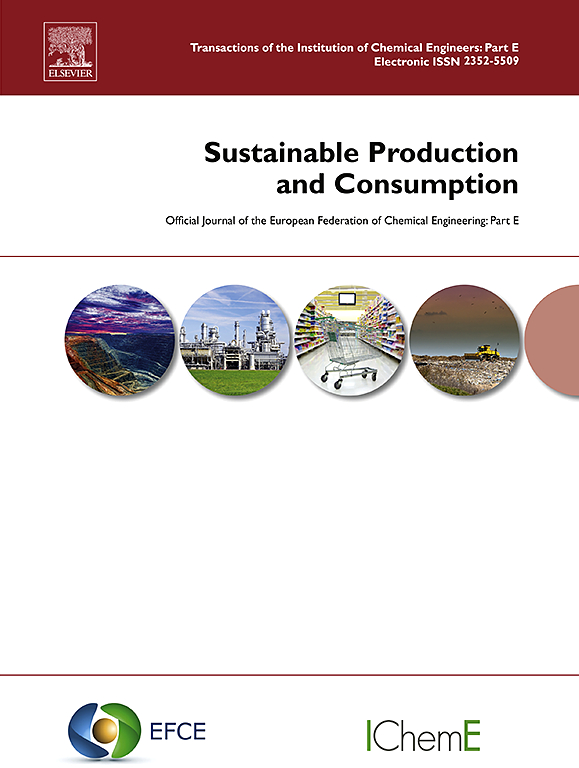将食用昆虫纳入循环农业,促进可持续生产
IF 10.9
1区 环境科学与生态学
Q1 ENVIRONMENTAL STUDIES
引用次数: 0
摘要
可持续农业面临着平衡环境管理、粮食安全和不断增长的全球人口需求的挑战。本研究探讨了如何将食用昆虫养殖纳入循环农业,以加强传统的种植和畜牧业实践,从而提高环境可持续性、粮食安全和经济增长。这项研究利用系统因果循环图(CLD),在多方利益相关者参与的支持下,构建了一个包含昆虫、作物和畜牧业的可持续农业详细系统图。因果循环图的网络分析使用了由 39 个变量和 101 条系统边组成的有向邻接矩阵,通过各种中心度量,揭示了对系统效率、稳健性和整体动态至关重要的关键决定因素。通过存量和流量模型模拟,对该系统的四种情景进行了评估,重点是黑实蝇(BSF)和蟋蟀养殖以及玉米和家禽养殖。对黑实蝇和蟋蟀进行评估,是因为它们在减少废物和养分循环方面发挥着双重作用,而这对促进农业可持续性和恢复力至关重要。该系统的反馈回路揭示了昆虫、作物和畜牧业之间错综复杂的相互作用,回路 B1-B18 和 R1-R17 显示了可持续的循环。网络分析显示信息传播迅速,平均路径长度为 3.89,边缘密度较低,仅为 6.82%,并强调昆虫饲养、就业、劳动力和农民人口是影响系统动态和效率的关键决定因素。存量和流量模型模拟显示,昆虫养殖与传统农业之间存在显著的协同效应。主要研究结果表明,将 BSF 和蟋蟀养殖融入玉米和家禽养殖系统后,玉米产量增加了 30%,家禽重量增加了 20%,5 年间共生产了 6000 公斤干 BSF 幼虫和 4000 公斤蟋蟀。养殖 BSF 的年利润增至 1400 美元,养殖蟋蟀的年利润超过 1000 美元。这项研究强调了系统互动和反馈回路在优化农业产出和可持续发展目标方面的关键作用,以显著提高可持续农业的生产率和经济可行性。它推动了全球向创新、弹性和循环农业实践的范式转变。该研究倡导采用食用昆虫养殖作为循环农业中可持续农业的基石,强调其在显著改善粮食安全、环境可持续性和经济可行性方面的潜力。建议包括推广昆虫养殖、支持小农、投资研发、加强市场准入以及将循环经济原则纳入农业政策。本文章由计算机程序翻译,如有差异,请以英文原文为准。
Integrating edible insect into circular agriculture for sustainable production
Sustainable agriculture faces the challenge of balancing environmental stewardship, food security, and the needs of a growing global population. This study examines how integrating edible insect farming into a circular agriculture can enhance traditional cropping and livestock practices, thus improving environmental sustainability, food security, and economic growth. Using system Causal Loop Diagram (CLD), the study constructed, with multi-stakeholder engagements support, a detailed system map of sustainable agriculture incorporating insect, crop, and livestock farming. The network analysis of the CLD used a directed adjacency matrix of 39 variables and 101 edges of the system to reveal key determinants that are central to the system's efficiency, robustness, and overall dynamics through various centrality measures. Through stocks and flows model simulations, four scenarios of the system, focusing on black soldier fly (BSF) and cricket farming with maize and poultry operations were evaluated. The BSF and crickets are evaluated for their dual role in waste reduction and nutrient cycling, which are pivotal in promoting agricultural sustainability and resilience. The system's feedback loops revealed intricate interactions between insect, crop, and livestock farming, with loops B1-B18 and R1-R17 showing sustainable cycles. Network analysis revealed rapid information spread with an average path length of 3.89, low edge density of 6.82 %, and highlighted insect rearing, employment, labour, and farmer population as pivotal determinants influencing the system's dynamics and efficiency. The stocks and flows model simulations showed significant synergies between insect farming and traditional agriculture. Key findings revealed that the integration of BSF and cricket farming into maize and poultry systems led to 30 % increase in maize production, 20 % increase in poultry weight with 6000 kg of dried BSF larvae and 4000 kg of crickets produced over 5 years. The annual profits increased to $1400 from BSF farming and over $1000 from cricket farming. The study highlights the critical role of systemic interactions and feedback loops in optimizing agricultural outputs and sustainability goals to significantly boost productivity and economic viability in sustainable agriculture. It catalyses a paradigm shift towards innovative, resilient, and circular agricultural practices globally. The study advocates for the adoption of edible insect farming as a cornerstone of sustainable agriculture within a circular agriculture, highlighting its potential to significantly improve food security, environmental sustainability, and economic viability. Recommendations include promoting insect farming, supporting smallholder farmers, investing in research and development, enhancing market access, and incorporating circular economy principles into agricultural policies.
求助全文
通过发布文献求助,成功后即可免费获取论文全文。
去求助
来源期刊

Sustainable Production and Consumption
Environmental Science-Environmental Engineering
CiteScore
17.40
自引率
7.40%
发文量
389
审稿时长
13 days
期刊介绍:
Sustainable production and consumption refers to the production and utilization of goods and services in a way that benefits society, is economically viable, and has minimal environmental impact throughout its entire lifespan. Our journal is dedicated to publishing top-notch interdisciplinary research and practical studies in this emerging field. We take a distinctive approach by examining the interplay between technology, consumption patterns, and policy to identify sustainable solutions for both production and consumption systems.
 求助内容:
求助内容: 应助结果提醒方式:
应助结果提醒方式:


